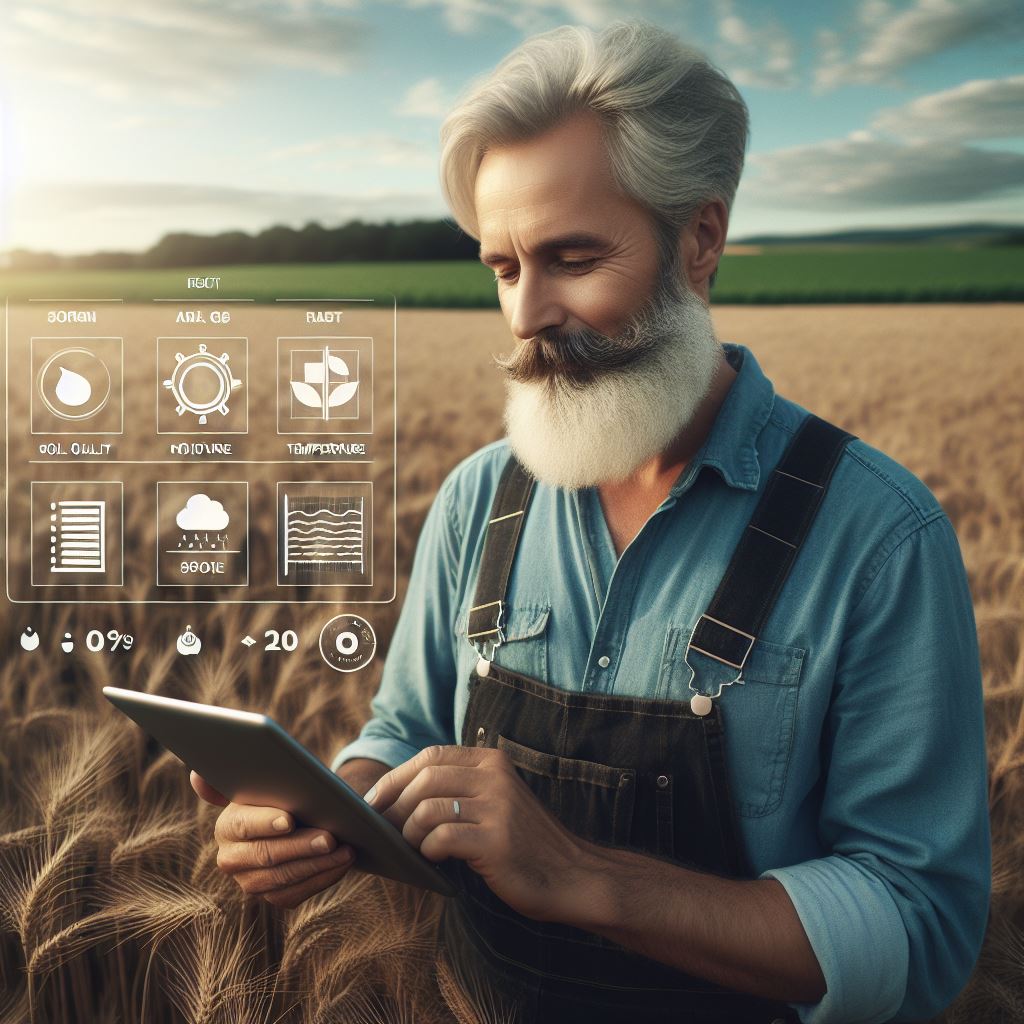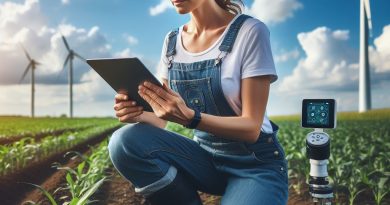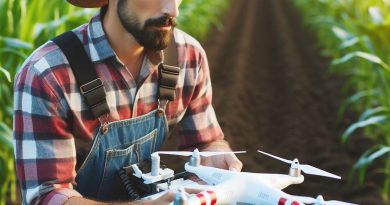Vertical Farming: Agri-Tech Rising Star
Last Updated on March 2, 2024
Introduction
Vertical farming is a modern method of growing crops indoors, using stacked layers or shelves, without soil.
It has gained popularity due to the increasing significance of agri-tech in sustainable agriculture.
In this blog post, we will explore the concept of vertical farming, its benefits, and its potential impact on the future of farming.
Vertical farming is a revolutionary technique that allows crops to be grown vertically, maximizing space utilization.
With the rise in global population and shrinking arable land, vertical farming offers a promising solution to ensure food security.
This blog post aims to highlight the numerous advantages of vertical farming, such as year-round crop production, reduced water consumption, and minimal pesticide use.
Furthermore, we will delve into the technologies utilized in vertical farming, such as hydroponics, aeroponics, and LED lighting systems.
By providing a controlled environment, vertical farming enables farmers to optimize crop growth, resulting in higher yields and improved quality.
Vertical farms can be established in urban areas, reducing the need for long-distance transportation and minimizing the carbon footprint.
Additionally, vertical farming reduces the risk of crop diseases and pests, as the closed system prevents external contamination.
We will also explore the economic viability of vertical farming and its potential as a sustainable business model in the agriculture industry.
In general, this blog post emphasizes the importance of vertical farming in meeting the growing demands for food production, while mitigating environmental concerns and resource limitations.
Vertical farming has the potential to revolutionize the way we grow crops, ensuring a greener and more sustainable future for generations to come.
Benefits of Vertical Farming
Increased crop yield and efficiency
Vertical farming allows for more crops to be grown in a smaller space, maximizing yield and reducing the need for expansive land.
Reduction in water usage and land space
Vertical farming utilizes hydroponics and aeroponics systems, which use significantly less water compared to traditional soil-based agriculture.
Additionally, it allows for the use of unused vertical spaces, reducing the need for vast amounts of land.
Minimal environmental impact
Vertical farming creates a controlled environment where pests and diseases can be minimized without the need for harmful pesticides.
It also reduces the carbon footprint by eliminating the need for extensive transportation of crops.
Year-round crop production
Vertical farming can bypass the limitations of seasons and climate, enabling crops to be grown year-round.
This ensures a stable food supply regardless of the weather or geographical location.
Potential for urban agriculture
Vertical farming has the potential to transform cities into food-producing hubs.
By utilizing unused spaces like rooftops or basements, urban areas can become self-sustainable in terms of food production, decreasing reliance on distant farms.
Job creation opportunities
As vertical farming continues to expand, there will be a need for skilled agricultural technicians, engineers, and other related professionals.
This can promote job creation and improve the economy in both urban and rural areas.
In short, vertical farming offers numerous benefits that make it a rising star in the field of agriculture technology.
Vertical farming, by increasing crop yield, efficiency, and creating job opportunities, presents a sustainable solution to traditional farming challenges.
With advancements in technology and further research, vertical farming has the potential to revolutionize the way we grow food and contribute to a more sustainable and resilient agricultural system.
Read: Smart Collars: Revolution in Livestock Health
Technologies Used in Vertical Farming
Vertical farming is revolutionizing the agricultural industry by utilizing advanced technologies to maximize crop production and minimize environmental impact.
The following technologies are commonly used in vertical farming:
Hydroponics system
The hydroponics system is one of the most widely used technologies in vertical farming.
It involves suspending plant roots in nutrient-rich water solutions that provide all the necessary nutrients for growth.
Without the need for soil, hydroponics allows for maximum space efficiency, reduces water usage by up to 90%, and eliminates the risk of soil-borne diseases.
Aeroponics system
Aeroponics takes hydroponics a step further by delivering nutrients to plants using a fine mist.
This method ensures that the roots receive optimal nutrients and oxygen, leading to faster growth and increased yields.
Aeroponics is particularly suitable for crops with short growth cycles, such as lettuce and herbs.
LED lighting
This plays a crucial role in vertical farming, as it enables plants to grow indoors without relying on natural sunlight.
LED lights emit the specific light spectrum required for photosynthesis, allowing plants to thrive.
Additionally, LED lights are energy-efficient, producing less heat than traditional lighting sources and reducing electricity costs.
Automation and robotics
The automation and robotics technologies used in vertical farming streamline various processes, reducing labor costs and increasing efficiency.
Automated systems can handle tasks such as seeding, watering, and harvesting, minimizing human involvement.
This ensures precision and consistency in crop production while reducing the risk of errors.
Climate-controlled environment
The climate-controlled environment in vertical farms eliminates the dependency on external weather conditions.
By maintaining optimal temperature, humidity, and CO2 levels, plants can grow year-round with consistent quality and yield.
This controlled environment also protects crops from extreme weather events and pests.
Data analytics and monitoring systems
- Data analytics and monitoring systems are essential for tracking and optimizing plant growth in vertical farming.
- By collecting data on parameters such as plant growth rates, nutrient levels, and environmental conditions, farmers can make informed decisions to improve crop cultivation.
- These systems enable real-time monitoring and remote management of vertical farms.
In summary, vertical farming utilizes various technologies to create a sustainable and efficient method of crop cultivation.
From hydroponics and aeroponics systems to LED lighting and automation, these technologies play a crucial role in maximizing production while minimizing the environmental impact.
Vertical farming presents a promising solution to the challenges of traditional agriculture and holds immense potential for feeding the growing global population.
Read: AgriTech Startups: Shaping Future Farming
Challenges of Vertical Farming
These challenges can significantly impact the success and widespread adoption of vertical farming.
However, despite these obstacles, the benefits of vertical farming cannot be overlooked.
Innovations and advancements in technology are continually addressing these challenges, reducing their impact and making vertical farming economically viable and sustainable.
High initial setup costs
Vertical farming requires significant investment in infrastructure, such as vertical grow systems, lighting, and climate control.
To overcome the high initial setup costs, initiatives such as grants, subsidies, and investment opportunities can be explored to support the establishment of vertical farms.
Governments and organizations can provide financial incentives and support to promote the growth of this industry.
Energy consumption
The artificial lighting and climate control systems used in vertical farming consume a considerable amount of energy, leading to increased electricity bills.
Efforts to reduce energy consumption in vertical farming include the use of energy-efficient LED lighting and harnessing renewable energy sources such as solar and wind power.
Implementing energy-saving practices and optimizing the use of resources can further mitigate energy consumption.
Dependency on technology and infrastructure
Vertical farming heavily relies on advanced technology and infrastructure to create optimal growing conditions, making it vulnerable to system failures or malfunctioning equipment.
Reducing dependency on technology and infrastructure can be achieved by developing reliable and redundant systems.
Backup power generators, data monitoring, and automation technologies can help ensure continuous operation even in case of equipment failure.
Crop diversity limitations
The vertical farming method is more suitable for certain crops, such as leafy greens and herbs, limiting the variety of produce that can be grown in vertical farms.
Crop diversity limitations can be addressed by leveraging research and development to optimize vertical farming techniques for a wider range of crops.
New methods such as aeroponics and aquaponics can be explored to expand the variety of produce that can be grown vertically.
Public perception and acceptance
- Traditional farming methods are deeply ingrained in society, making it challenging for vertical farming to gain widespread acceptance and overcome skepticism from consumers.
- To tackle public perception and acceptance, education and awareness campaigns can play a crucial role.
- Highlighting the advantages of vertical farming, such as reduced water usage, limited pesticide use, and year-round production, can help change public perception and promote acceptance.
In a nutshell, Continuous innovation conquers vertical farming challenges: setup costs, energy use, tech dependency, crop limits, and public perception.
By addressing these challenges head-on, vertical farming can pave the way for a more sustainable and resilient future of food production.
Read: Farm Data Analysis: Improving Sustainability
You Might Also Like: Next-Gen Greenhouses: Automation in Play
Success Stories in Vertical Farming
Vertical farming, an innovative approach to agriculture, is gaining popularity worldwide.
Many success stories have emerged in this field, showcasing the potential and impact of this agri-tech solution.
Let’s take a closer look at some notable success stories in vertical farming:
The Plant (Chicago, USA)
The Plant is a vertical farming project located in Chicago, USA, which focuses on sustainable practices.
It uses a unique closed-loop ecosystem, where waste from one process becomes input for another.
With a variety of crops, they aim to provide fresh and healthy produce to local communities.
Sky Greens (Singapore)
Singapore, known for its limited land resources, has embraced vertical farming as a solution.
Sky Greens is one such example of successful implementation.
Using innovative vertical greenhouses, they grow vegetables vertically, optimizing space and reducing water usage.
By bringing farms closer to urban areas, they minimize transportation distances and offer fresher produce.
AeroFarms (Newark, USA)
AeroFarms, located in Newark, USA, is revolutionizing agriculture with its vertical farming techniques.
By growing plants in a controlled environment using aeroponics, they maximize yields while minimizing resource consumption.
Their approach allows them to grow crops without soil and with significantly less water than traditional farming methods.
Infarm (Germany)
Infarm, based in Germany, aims to transform cities into productive food ecosystems.
They utilize modular vertical farming units placed in supermarkets, restaurants, and other urban environments.
By growing herbs, leafy greens, and vegetables locally, they reduce food waste and transportation costs, offering consumers hyper-local and ultra-fresh produce.
Plenty (San Francisco, USA)
- Plenty, headquartered in San Francisco, USA, is focused on reimagining how food is grown and distributed.
- Their vertical farms use a combination of artificial intelligence, data analytics, and robotics to optimize plant growth conditions.
- Through their efficient and scalable model, they aim to make high-quality, nutritious food more accessible and sustainable.
The success stories of The Plant, Sky Greens, AeroFarms, Infarm, and Plenty demonstrate the immense potential of vertical farming.
These ventures are not only addressing food security and sustainability but also redefining the dynamics of farming in urban areas.
With ongoing advancements and increased adoption, vertical farming is set to play a crucial role in the future of agriculture.
Read: Greenhouse Tech: Future of Controlled Agri

Investment and Market Growth in Vertical Farming
Vertical farming, also known as indoor farming or urban agriculture, is quickly emerging as a rising star in the field of agri-tech.
It involves growing crops in vertically stacked layers, often in controlled environments such as warehouses or greenhouses.
This innovative approach to agriculture offers numerous benefits, including increased food production, reduced water usage, and minimal reliance on pesticides.
Increasing investments and funding in agri-tech startups
One of the key factors contributing to the growth of vertical farming is the increasing investments and funding in agri-tech startups.
Venture capitalists and other investors are recognizing the potential of this industry and are putting their money into companies that are developing cutting-edge vertical farming technologies.
This influx of capital has helped drive research and development, leading to the creation of more efficient and productive farming systems.
Growing market demand for sustainable and locally produced food
In addition, there is a growing market demand for sustainable and locally produced food.
Consumers are becoming increasingly conscious about the environmental impact of traditional farming methods, such as long-distance transportation and excessive water usage.
Vertical farming addresses these concerns by offering a more sustainable and efficient way of growing food.
By producing crops closer to urban areas, vertical farms can reduce the carbon footprint associated with transportation, while using significantly less water than conventional agriculture.
Future projections and potential growth opportunities
- The market potential for vertical farming is vast, with future projections indicating substantial growth opportunities.
- According to a report by the United Nations, the global population is expected to reach 9.8 billion by 2050.
- This population growth, coupled with urbanization, will place increasing pressure on the agricultural sector to produce more food in limited space.
- Vertical farming provides a viable solution by maximizing crop yields per square foot of land, enabling food production to keep pace with the growing population.
- Furthermore, vertical farming can help address food security issues by providing a consistent and reliable food source.
- With traditional farming methods, crops are susceptible to external factors such as climate change, pests, and diseases.
- Vertical farms, on the other hand, can control these variables through the use of climate-controlled environments and advanced monitoring systems.
- This ensures a stable production of crops throughout the year, regardless of external conditions.
- The potential applications of vertical farming extend beyond traditional crops.
- With advancements in technology, it is now possible to grow a wide range of produce, including leafy greens, herbs, and even certain fruits.
- This diversification of crops offers additional market opportunities and allows vertical farmers to cater to specific consumer demands.
All in all, vertical farming is a rapidly growing industry within the agri-tech sector.
Through increasing investments and funding, growing market demand for sustainable food, and future growth projections, vertical farming presents immense potential for both investors and farmers.
As the world population continues to rise, the need for innovative and sustainable food production methods becomes increasingly vital.
Vertical farming has the capability to revolutionize the agricultural sector, providing a solution to the challenges of land scarcity, water usage, and food security.
Conclusion
Vertical farming offers numerous benefits such as increased crop yields, efficient land use, and reduced water consumption.
However, it also poses challenges like high startup costs and the need for advanced technology and expertise.
Despite these challenges, vertical farming has the potential to revolutionize agriculture by providing a sustainable solution to food production in urban areas.
The ability to grow crops in a controlled environment, free from pests and adverse weather conditions, can significantly increase food security and supply.
Vertical farming also allows for year-round cultivation, reducing dependence on seasonal crops and vulnerability to climate change.
This technology has the power to transform underutilized spaces such as abandoned buildings into productive urban farms, contributing to the greening of cities.
Furthermore, vertical farming promotes the efficient use of resources by recycling water, utilizing vertical space, and minimizing the use of pesticides and fertilizers.
This sustainable approach not only conserves natural resources but also reduces the carbon footprint of agriculture.
However, there is still a need for further research and advancements in the field of vertical farming.
Innovations in lighting systems, energy efficiency, automation, and plant nutrition are essential to optimize productivity and reduce costs.
Collaboration between scientists, agronomists, engineers, and entrepreneurs can drive progress in this field and unlock the full potential of vertical farming.
Vertical farming represents a promising future for agriculture.
Its ability to provide fresh produce in urban areas, reduce dependence on traditional farmland, and mitigate environmental impact makes it an attractive solution.
As we move towards a more sustainable and resilient food system, it is crucial to support and invest in the research and development of vertical farming to ensure its success and widespread adoption.
By doing so, we can create a sustainable and inclusive future for generations to come.


